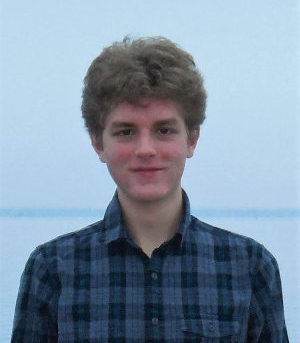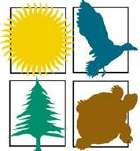WCLT Scholarships 2022
WCLT Scholarships 2022 Awarded
The Westborough Community Land Trust (WCLT) awarded two $1,000 scholarships and two honorable mentions to graduating Westborough High School (WHS) seniors. These awards were made on the basis of student essays written for WCLT’s annual Earth Day Essay Contest.
“This year’s group of essays was more upbeat than last year’s, probably due to life being less dominated by the pandemic. Nature helped several students cope,” said Annie Reid, WCLT scholarship committee chair. “Also, we could tell from the essays that WCLT's long-running, annual town-wide Earth Day Cleanup has been helping to raise kids’ awareness of both the litter problem in town and the beauty of our natural environment. Students mentioned using the town’s trails and conservation areas, including the Charm Bracelet trails, Mill Pond, Lake Chauncy, Bowman Conservation Area, Hoccomocco Pond, and Sawink Farm. We saw that courses in art, photography, and environmental science helped students develop environmental consciousness, as did families and scouting.”
Harrison Smith won a scholarship for his essay describing both his reawakening to nature and the beauty of Westborough through a surprise trailside encounter with a swan and his intention to “play the swan” by helping other people connect with nature. He will attend Boston College in the fall.
Chocoria Jiang received a scholarship for her essay describing the role that Lake Chauncy played in inspiring her appreciation for all bodies of water, the growth of her interest in the oceans and marine conservation, and her use of art to focus awareness on marine conservation issues. She plans to attend NYU for an individualized major in studio art, design, and environmental studies.
The winning essays essays can be read below.
Sophie Scerbin received an honorable mention for her essay describing how positive experiences on the trails at Mill Pond with the Girl Scouts and at the Westborough Reservoir brought her closer to nature and inspired her to create a program with interactive activities that help children experience nature and the world outside their phones. She plans to attend Roger Williams University.
Lindsay Hall was recognized with an honorable mention for her essay describing how she found peacefulness in nature and relief from stress after tumbling to the ground while jogging on Mill Pond trails, and how she has been motivated to give back to the environment by picking up trash and seeking ways to protect the environment. She will attend a four-year college.
Since 2006, WCLT has awarded 28 scholarships to graduating seniors in Westborough and 28 honorable mentions. (See the WCLT Scholarship Hall of Fame.) With our Earth Day essay contest and scholarship program, WCLT aims to inspire young people to become keen observers of our natural spaces, as well as reflective thinkers regarding the impact of human activity on our environment.
Harrison Smith’s Earth Day essay 2022:

There can come a time in life where color begins to fade from the surroundings. When the wind howls without nuance, and each sunset fades quickly into the grayscale memory bank of dusks elapsed—such a time was when my interest in the outdoors began to wane. This was unusual for me. Having been raised with a healthy exposure to the outdoor environment, I had assumed the relationship between nature and me had been forged immutably. In practice, I had lent a hand through scouting to mark trails throughout the town and watch them piece together like chain-link over the years. Perhaps it’s this familiarity with the trails of Westborough that bred the assumption of natural monotony.
Practice eroded to theory as I stopped experiencing the outdoors in lieu of defining it by cycles of boredom, stepping outside only to escape the house rather than to explore any destination. It was on one of these escapes last year that I had visited Mill Pond—a couple of miles out and back through the woods seemed to offer familiarity in steady motion, like a treadmill. What they offered instead was a great wall of feathers cutting through the air as it fanned out only several feet in front of me. A swan was nesting adjacent to the path, nervous enough in demeanor and shocking enough in size to suggest I turn around and take an alternate route. Jarred by such a close encounter, I watched as other sights cut through the scene like flowers from dirt. Baby turtles lay by the edge of the water, and mergansers swam through a branch which sprouted from the pond. Such things I had never seen at Mill Pond before, and in passing they tugged not at preconceptions about the area but at distant memories of Audubon books and TV shows with plants and animals I had hoped I’d once see. Beauty and variety were exciting—like a rekindling of all I’d devoted myself to in youth—and were easy to find.
It’s easy to project oneself onto the outdoors and believe that nature is predictable, existing only where you look and thriving only where people allow it. My experience at Mill Pond was the first of many in Westborough that have led me to perceive this notion as false. The unpredictability with every rustling of leaves, every gust of wind, and every passing bird promises an eternal variety that defines every inch of the changing environment and transcends space, equally present throughout Westborough as it is atop distant mountains. Ebbs and flows of nature are perpetual, therefore the responsibility on the shoulders of people is merely to see them. A year ago, my perception was clouded by reflections of self, but at times this cloud can be as simple as fog on a window or litter on the side of the road. To teach others about the natural environment and create opportunities to explore it are to play the swan, interrupting stagnant and circular paths with new branches into the unknown. Naturally, this process begins with small steps towards the water—I’ve been building planting beds for the schools to use, for example. I hope they may harbor sprouts of curiosity as they open the door to further conservation efforts among students.
One day soon I will leave Westborough to attend college with an aim of exploring natural sights around where I’ll live. I once viewed this aim with a certain desperation, eager to depart the familiarity of the town to seek new things. Having opened my eyes to Westborough’s beauty, I know now that when I return to the town after months of living away, the natural environment will be the same as from where I came—united in their infinite diversity, each setting will prove equally unfamiliar.
Chocoria Jiang’s Earth Day essay 2022:

When I was growing up in Westborough, the town was my suburban safe haven: I grew up in a bubble, given many privileges, protected by a healthy community, and encouraged by a high-achieving education. I took for granted many of these advantages, and never realized how much I was being supported throughout my life. To be straight, I became bored with life in Westborough. The city, to me, was much more vibrant, filled with life and new challenges, whilst Westborough was filled with the same natural sites. I didn’t care for the ponds or the trails: observing the quiet outdoors wasn’t exactly invigorating.
So when COVID came around early in 2020, I was discouraged. What was there to do with so much free time? My mom encouraged us to hike difficult trails as a way to get us out of the house each day. Although I initially dreaded these trips, I found consolation in the quiet times outdoors as I began to understand my mom on a deeper level. We went to the Chauncy Lake loop constantly, becoming familiar with the groves and fallen tree stumps as spring turned into summer. When I could finally hang out with a friend, we picnicked on the shore in front of the lake, watching sunsets and piling on blankets when the wind began to blow everything away. In summer I watched from the back of the trunk as friends stood at the edge of the water, fishing, their voices drowned out by the car stereo. That year, I got to see, for the first time, the beauty of Lake Chauncy from so many different vantage points. Slowly but surely, I realized what it was becoming for me: a way to discover my friends on a deeper level, and a way to be quiet with myself as my eyes followed the repeated motion of the waves.
Lake Chauncy was the first dabble in my gradual appreciation for all bodies of water. That summer, I never wasted a chance to go jump over countless waves at the beach, or sit on a blanket, immersed in a novel as a river flowed beneath. Eventually, it became routine: standing at shore, looking out to the horizon, getting lost in my thoughts as I attempted to identify all the colors I saw being reflected in the water. These bodies of water, wherever they happened to be, were a safe haven for me. I loved the city’s excitement, but I came to love the unwavering nature of these waters even more.
My curiosity about the ocean in particular led me to discover issues in marine pollution. When environmental activism eventually became the focal point of my desire for societal change in freshman year, I was introduced to the potential for art to address climate crises. As an artistic student, being able to find a real purpose for my art was a large step forward in discovering where my true interests lay. Through art teachers, online resources, and competitions, I started to find more ways to integrate issues in marine conservation into my art. I’ve since learned to use art as a tool for advocacy and communication through creating climate-related infographics; creating art pieces addressing specific issues on marine pollution; and taking courses in sustainable design as a way to immerse myself in the journey. On my own, I have run a school-wide environmental art competition at WHS, sent Climate Art for Congress Letters with peers, and created my own unique art pieces addressing issues like coral bleaching and marine life preservation. This year, I am using my AP Drawing concentration, “Human Connection to the Ocean,” to continue displaying these passions in the best way that I can. As I move into college, I seek to find more interdisciplinary, professional ways to contribute to oceanic preservation.
The appreciation for my environment and close community that Chauncy filled me with has allowed me to find out more about myself than I could have ever imagined. To some, Chauncy may appear to be just another natural site of Westborough, but I can be the first to say that it has the potential to mean so much more if we spent time watching its unchanging beauty in the midst of our fleeting lives. As I look into my future, I hope to instill in others what I have learned from Lake Chauncy about the significance of our environment, so that we all may give back to the earth that has provided so much for us.
Westborough Community Land Trust, PO Box 838, Westborough , MA 01581
-- Contact -- Contribute or Join! --

